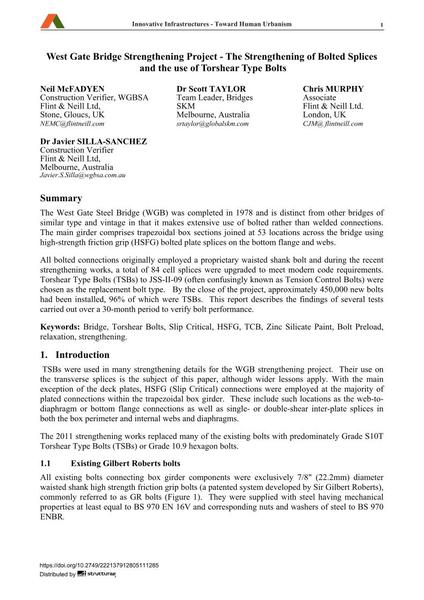West Gate Bridge Strengthening Project - The Strengthening of Bolted Splices and the use of Torshear Type Bolts

|
|
|||||||||||
Bibliographic Details
| Author(s): |
Neil McFadyen
Scott Taylor Chris Murphy Javier Silla-Sanchez |
||||
|---|---|---|---|---|---|
| Medium: | conference paper | ||||
| Language(s): | English | ||||
| Conference: | 18th IABSE Congress: Innovative Infrastructures – Towards Human Urbanism, Seoul, Korea, 19-21 September 2012 | ||||
| Published in: | IABSE Congress Seoul 2012 | ||||
|
|||||
| Page(s): | 887-894 | ||||
| Total no. of pages: | 8 | ||||
| DOI: | 10.2749/222137912805111285 | ||||
| Abstract: |
The West Gate Steel Bridge (WGB) was completed in 1978 and is distinct from other bridges of similar type and vintage in that it makes extensive use of bolted rather than welded connections. The main girder comprises trapezoidal box sections joined at 53 locations across the bridge using high-strength friction grip (HSFG) bolted plate splices on the bottom flange and webs. All bolted connections originally employed a proprietary waisted shank bolt and during the recent strengthening works, a total of 84 cell splices were upgraded to meet modern code requirements. Torshear Type Bolts (TSBs) to JSS-II-09 (often confusingly known as Tension Control Bolts) were chosen as the replacement bolt type. By the close of the project, approximately 450,000 new bolts had been installed, 96% of which were TSBs. This report describes the findings of several tests carried out over a 30-month period to verify bolt performance. |
||||
| Keywords: |
bridge strengthening relaxation Torshear Bolts Slip Critical HSFG TCB Zinc Silicate Paint Bolt Preload
|
||||
